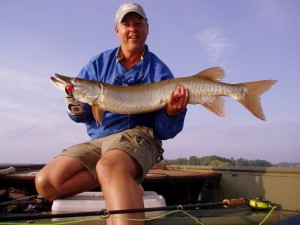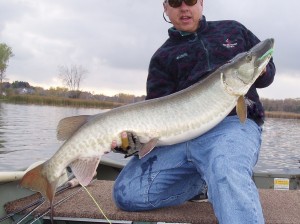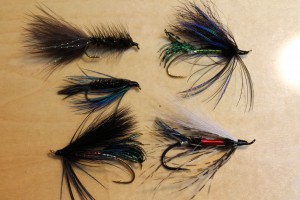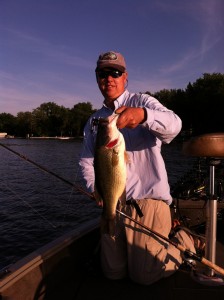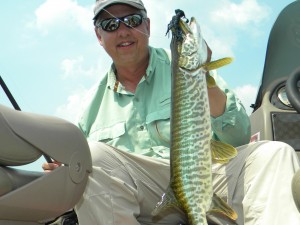I’m not 100% sure what has caused to uptick in the interest in chasing muskies with the fly rod [those guys in Northern Wisconsin run a great program and probably have A LOT to do with it]. But despite what social media postings may lead you to believe [hardly a day will pass this summer without a fly-caught muskie showing up on Facebook], catching a muskie on a fly is still one of the biggest challenges to fly rodders. No matter where you decide to flail, a typical day of fly casting for muskies involves many hours of flogging the waters with the heaviest fly rod you own, casting a fly the size of a squirrel. At some point during the day a muskie will eat your fly, at which point you will probably be so surprised that you will either not react at all, or worse yet, raise your rod tip in a trout-style hook set. Both of these are likely to result in bad words and no pictures. Spending time on high percentage waters, like the fine rivers of northern Wisconsin will up the odds that you will get multiple shots per outing.
But did you know that there are high percentage waters right here in the Twin Cities? It’s true, there are over a dozen lakes right here in the Metro that have strong, fishable populations of muskies. Lakes like Independence, Eagle, White Bear, Forest—these all have muskies— with good numbers AND size. Every one of these lakes has produced many fish over 50 inches, and these fisheries compare favorably with any other muskie water anywhere.
Here is a typical metro area muskie, this one ate a popper
There is lots more to muskie fishing than just catching fish, and if you are thinking of planning a muskie trip to the North Woods you should do so. To smell the pines and the fresh air, to hear the loons but not the cars, to take in a North Country Sunset, these are all things you should do at least once a year.
But if you want to get a primer or a refresher course on muskie fishing, perhaps you want to see if you are up the many hours of flogging with the big rod, maybe you want to get tuned up for your big trip, here is what I am offering: From now through ice up, muskies are available to flyrodders on several of my favorite lakes, and you and a friend can get in on the action for only $250! This is a weeknight venture, I will meet you and your partner [you can fish alone, too] at a local lake at 5:00 and we will fish until dark. All tackle will be provided, you just need to show up with a can-do attitude, and let me put you on the fish. I have my favorite lakes, where we will fish will depend on conditions and where you are coming from. It is likely that the boat launch will be 30 minutes or less from where you live or work.
I didn’t say it would be easy, but it is totally doable, and it is likely that we’ll have some good chances at muskies, and probably catch a few bass and pike along the way. You’ll learn the water, learn the techniques, and be in great shape for your next adventure.
While I am promoting this primarily to fly rodders, anglers with all types of gear are welcome. If you want to fly fish but want to split the trip with someone using gear, that’s just fine. [Don’t worry, the guy with the fly rod will always get the front of the boat!]
Here is me with a bigger than average one from a favorite lake. I didn’t measure it, let’s call it 49 3/4″. You can see the tail of the fly in its mouth.
This is the fly I caught it on, I tied it in 5 minutes before I left to go fishing
These are more typical of what I use, not too big, but they move plenty of water. Easy to cast on a 10 weight and the fish like to eat them !
MUSKIE FISHING WITH A FLY “TOP TEN LIST”
1.Fish water with a good population of fish
2.Fish when the conditions are right–wind is bad-bad for casting, boat control, and line management. Low light periods are key, especially during summer. My perfect muskie fishing day would be light wind, overcast, maybe a little light rain.
3.Have the right equipment, a 10 weight rod [or heavier] with a line to match.
4.Use a short, heavy leader with wire bite tippet.
5.Strip the fly to within a few feet of your rod tip EVERY cast, watching for following fish.
6.Be an efficient caster [can you make a 50′ cast with one back cast?]
7.Use a big fly with a big sharp hook [at least a 4/0 or 5/0]. But don’t over do it–if your fly is too big, casting stops being fun
8.When a fish eats your fly, set the hook with a “strip set”.
9.Have good boat control.
10.Have realistic expectations–casting all day for one or two “eats” is standard.
]]>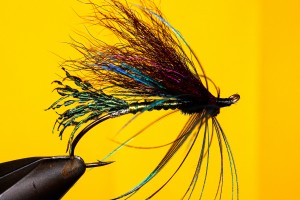 There was a time when I tied flies a lot. Almost every night in my smoky one room apartment you would find me drinking cheap beer and adding to my inexhaustible supply of flies. There were, and still are, certain flies that I can’t ever seem to have enough of—things like trout and steelhead nymphs or smallmouth poppers are good examples of flies that even today I need to keep after. But back then I worked at a fly shop, surrounded by the finest tying materials and hooks for most of my day. Since tying materials are pretty cheap, it was easy enough for me to constantly augment my supply of fur, feathers and synthetics. It was a pretty simple, yet enjoyable existence. The fun of tying more tarpon flies than 100 guys could use in a 100 years. I wish I had some pictures of the old apartment. I’m sure that it resembled a cross between a homeless shelter and a tackle shop. In fact one night a friend crashed on my floor, he complained the next morning that when he woke up he had rolled onto a pile of crankbaits.
There was a time when I tied flies a lot. Almost every night in my smoky one room apartment you would find me drinking cheap beer and adding to my inexhaustible supply of flies. There were, and still are, certain flies that I can’t ever seem to have enough of—things like trout and steelhead nymphs or smallmouth poppers are good examples of flies that even today I need to keep after. But back then I worked at a fly shop, surrounded by the finest tying materials and hooks for most of my day. Since tying materials are pretty cheap, it was easy enough for me to constantly augment my supply of fur, feathers and synthetics. It was a pretty simple, yet enjoyable existence. The fun of tying more tarpon flies than 100 guys could use in a 100 years. I wish I had some pictures of the old apartment. I’m sure that it resembled a cross between a homeless shelter and a tackle shop. In fact one night a friend crashed on my floor, he complained the next morning that when he woke up he had rolled onto a pile of crankbaits.
Somewhere along the way it appears that the smoky apartment has been replaced by a nice house, a wife and two kids have appeared, and the never ending 12 packs of cheap beer has been replaced by a couple of Summits. And while I still tie flies out of necessity, my nights of “recreational tying” are mostly a thing of the past. I now have a designated fly tying room, which makes it possible to get tying right away when the mood strikes.
Despite the thousands of flies I have tied, I still don’t consider myself to be a great tyer. If you need some durable, effective flies tied up in a hurry, then I’m your man. If you looking for a dozen that look just like the ones in the catalogs and on-line websites, please look elsewhere. I figured out at an early age that a simple scruffy fly will work just as well, and maybe better than an ultra-realistic fly, tied with jointed legs, antenna, eyes, genitalia, DNA sequencing, etc. Case in point—I was about 10 or 11, I’ve caught a whole lotta trout by this time in my life, but all on worms, a few on Mepps. My interest in catching a trout on a fly was strong though, and my grandpa would often rig up my Herter’s fly rod for me to flail away at rising trout with. One day I was working up a good froth at the bottom end of our favorite worm dunking hole, and much to everyone’s amazement, I ended up with a good sized trout on the line. The fly that I was using was one my grandpa called the “Black Nothing”, probably because it was just black fur on a hook. After the capture, he cleaned the trout streamside and showed me that it had several black beetles in its stomach. “That’s why it ate your black fly” he said, “it thought it was another one of these beetles”. Alright, black fur on a hook = beetle. Got it. I had simplified matching the hatch and flyting before it ever had a chance to get complicated on me.
So, combine that with my natural lack of artistic ability, and you’ve got a guy that is going to tie a fly that is good enough catch fish, but no better. In an hour, I can get well over a dozen of my scruffy specials done. On the other hand, someone who might be considered a “great” tyer, would probably be able to get half that many done. They would likely be perfect ties, but would they catch any more fish than the stuff I tie and fish with?
My friend JD “Redfern” LeCompte contacted me from his California ranch recently, letting me know he had an abundance of peacock feathers he had gleaned from their semi-tame flock, wondered if I could use them for fly tying. He sent a couple of pics of the plumage he had gathered, much of it was pretty standard tying stuff– eyed plumes and some swords, stuff that is easy to come by. But some of the feathers were stuff I had never seen before, and I wasn’t sure how I could use them. A week or so later I had an envelope in my mailbox that was overflowing with peacock. I was determined to set aside a night for “recreational tying”. 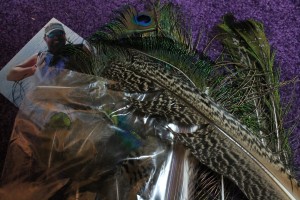
Once you start tying flies, you start looking at the world a little differently. As in “What could I tie with that?” every time you see a rug, a pet, a sweater, or fresh roadkill. An old girlfriend once forbid me to put a skunk tail in the trunk of her car [it only smelled a little—and the hair was really nice and long!], and I still have the tail of an albino squirrel that was dead in the middle of the road in downtown Farmington, Minnesota. Joe Vasquez was with me, we were running late for work on a Sunday after a morning mission to Hay Creek. When I first saw it on the centerline, I figured it was a cat, but as I passed it, nope, that’s a white squirrel—must have! I did a quick U-turn, pulled over and hacked the tail off with a dull knife. We still made it the Orvis store Downtown by 11. That tail is still in my collection.
In the package of peacock, there were some great looking body feathers that I suspected would be choice for tying “Spey” style flies. Spey flies are a traditional style of fly that still have a dedicated following. I’ve never tied very many, and I’ve certainly never fished with them, but they are very attractive. I was able to pull off a few “Spey” or “Spider” patterns that probably won’t see any time on the water, but will look really cool in one of my fly boxes dedicated to such things.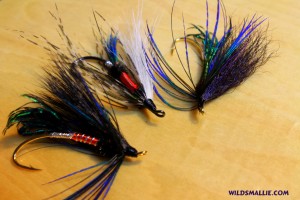
Peacock herl is very useful for tying trout and steelhead nymphs, and this stuff in the package was top notch. A few nymphs and a bugger for good measure will all go into a working box.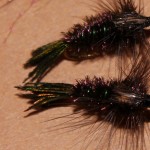
A popular “attractor” pattern here in the Midwest is the “Pass Lake”. It’s sort of a streamer/wet fly that doesn’t really look like anything, but on some days the trout can’t get enough of it. They are traditionally tied with black chenille for the body, but choice peacock herl works as good or better. The wing is supposed to be calf tail, these have the wing crafted of the aforementioned albino squirrel tail. I have always tied them with a red head. It’s fun to stray from my usual tying–only tying stuff I need. Maybe if I did this a little more I could actually become a good fly tyer.
It’s fun to stray from my usual tying–only tying stuff I need. Maybe if I did this a little more I could actually become a good fly tyer.
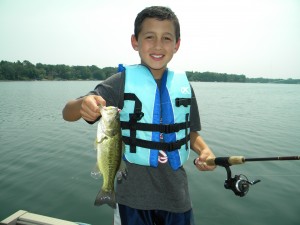
- Mason Johnston from Shawnee, KS
Yeah, yeah, the rivers have been too high. The Mississippi has been flowing at over 20,000, the St Croix over 10,000, even the Rum has been approaching 5,000 CFS. No one loves river fishing as much as me, and I will always take water that is a little too high over water a little too low. Current water levels are just not doable though–fish could still be caught-I’ve done it-but the dynamic of the fishing changes a lot and there are serious safety concerns. Last year it was well into July before the Miss was really fishable, this year it looks like we have about another week before the river will be at a fishable, albeit high, level.
Looking forward to lots of good days in the weeks to come. Local Largemouths [and largemouth enthusiasts!] are enjoying the fact that lake levels are on the rise, and huge numbers are possible. A trip with two guys on Monday produced around 30 largemouth, and a trip last week with a friend saw numbers approaching 50. Of course there’s always a few pike in the mix, maybe a muskie, and I’ve always got an eye out for big panfish. On Monday we found some full sized gills [8″+] still hanging around beds. These provided an interesting diversion, and I was really wishing for a fly rod in the boat.
]]>